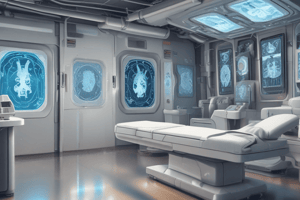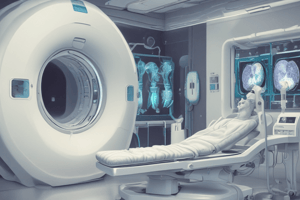Podcast
Questions and Answers
What is the angular offset between the X-ray tube and the corresponding detector array in Dual Source mode?
What is the angular offset between the X-ray tube and the corresponding detector array in Dual Source mode?
- 120 degrees
- 90 degrees (correct)
- 180 degrees
- 45 degrees
What is the advantage of Dual Source Single Energy mode?
What is the advantage of Dual Source Single Energy mode?
- Higher resolution
- Increased speed of acquisition (correct)
- Improved image quality
- All of the above
What is the key to high sensitivity and specificity in Dual Source Dual Energy imaging?
What is the key to high sensitivity and specificity in Dual Source Dual Energy imaging?
- Simultaneous dual energy acquisition
- Dual detector layers
- Different kV-settings for the two X-ray tubes (correct)
- Fast kilovoltage switching
What is the characteristic of Single Source Dual Energy mode?
What is the characteristic of Single Source Dual Energy mode?
What is the benefit of Dual Source mode in terms of resolution?
What is the benefit of Dual Source mode in terms of resolution?
What is the advantage of Dual Source Dual Energy mode?
What is the advantage of Dual Source Dual Energy mode?
What is the characteristic of the detector in Single Source Dual Energy mode?
What is the characteristic of the detector in Single Source Dual Energy mode?
How many images are acquired per location in Dual Energy CT?
How many images are acquired per location in Dual Energy CT?
What is the primary advantage of increasing the number of detector rows in a CT scanner?
What is the primary advantage of increasing the number of detector rows in a CT scanner?
What is the relationship between detector row number and slab thickness per gantry rotation?
What is the relationship between detector row number and slab thickness per gantry rotation?
What is the effect of having smaller detectors in a CT scanner?
What is the effect of having smaller detectors in a CT scanner?
How can slice thickness be varied in a CT scanner?
How can slice thickness be varied in a CT scanner?
What is the purpose of linking pairs of detectors in a CT scanner?
What is the purpose of linking pairs of detectors in a CT scanner?
What determines the slab thickness per gantry rotation in a CT scanner?
What determines the slab thickness per gantry rotation in a CT scanner?
What is the advantage of using a multislice scanner over a single slice scanner?
What is the advantage of using a multislice scanner over a single slice scanner?
What is the relationship between the number of detector rows and the strain on the x-ray tube?
What is the relationship between the number of detector rows and the strain on the x-ray tube?
What determines the slice thickness in multiple detector arrays?
What determines the slice thickness in multiple detector arrays?
What problem was encountered with single detector row scanning (SSCT)?
What problem was encountered with single detector row scanning (SSCT)?
What is the detector pitch defined as?
What is the detector pitch defined as?
What is the relationship between beam pitch and collimator pitch in multiple-row detector CT scanners?
What is the relationship between beam pitch and collimator pitch in multiple-row detector CT scanners?
What is the main advantage of Dual Source CT (DSCT) scanners?
What is the main advantage of Dual Source CT (DSCT) scanners?
What is the purpose of the collimator in multiple-row detector CT scanners?
What is the purpose of the collimator in multiple-row detector CT scanners?
What is the main limitation of single detector row scanning (SSCT)?
What is the main limitation of single detector row scanning (SSCT)?
What is the advantage of multiple-detector row CT scanners over single-row detector CT scanners?
What is the advantage of multiple-detector row CT scanners over single-row detector CT scanners?
What is the term used to describe the acquired X-ray beam thickness?
What is the term used to describe the acquired X-ray beam thickness?
What is the effect of the dominant cone beam in MSCT compared to fan beam shape in SSCT?
What is the effect of the dominant cone beam in MSCT compared to fan beam shape in SSCT?
Why do X-ray beams 180° apart sample the same tissue planes but with slightly different cone-shaped beam sampling?
Why do X-ray beams 180° apart sample the same tissue planes but with slightly different cone-shaped beam sampling?
What is the result of partial volume streaking in MSCT?
What is the result of partial volume streaking in MSCT?
What is the advantage of MS/MD CT in terms of speed?
What is the advantage of MS/MD CT in terms of speed?
What is the effect of opening up the collimator in conventional single detector array scanners?
What is the effect of opening up the collimator in conventional single detector array scanners?
What is the relationship between cone beam artifact severity and the number of detector rows?
What is the relationship between cone beam artifact severity and the number of detector rows?
What is the advantage of MS/MD CT in terms of producing images?
What is the advantage of MS/MD CT in terms of producing images?
What is the primary advantage of dual energy spectral data over traditional structural only images?
What is the primary advantage of dual energy spectral data over traditional structural only images?
What is the basis for delineating structures when using two energies?
What is the basis for delineating structures when using two energies?
What determines the degree of X-ray beam attenuation by a material?
What determines the degree of X-ray beam attenuation by a material?
What is the effect of changing photon energy levels on tissue attenuation?
What is the effect of changing photon energy levels on tissue attenuation?
What is the inherent contrast generation of the image dataset dependent on?
What is the inherent contrast generation of the image dataset dependent on?
What is the primary factor that determines the unique energy-dependent attenuation profiles of calcifications and contrast material?
What is the primary factor that determines the unique energy-dependent attenuation profiles of calcifications and contrast material?
Flashcards are hidden until you start studying
Study Notes
Multislice Computed Tomography (MSCT)
- Increasing the number of detector rows in MSCT scanners increases the z-axis coverage slab thickness, reducing the number of gantry rotations necessary to image the selected field of view (scan length).
- The z-axis coverage (slab thickness) per gantry rotation is directly proportional to the detector row number.
MSCT Scanner Development
- Subsequent MSCT scanners possessed increasing numbers of detector rows, starting at 16 rows and moving to 64, 156, and 320 rows.
- The coverage (slab thickness) varies by detector row number, where slab thickness per gantry rotation is directly proportional to detector row number.
Detector Array and Slice Thickness
- The entire detector array consists of groupings, each connected to the mother board unit of the detection system.
- Each group can be selectively activated or deactivated, providing various slice thicknesses that may be predetermined depending on the scan indication.
- Detector arrays within a given row may be varied, with inner detector rows made up of narrower detectors than outer rows, which can be selectively activated to narrow the slice thickness.
Beam Configuration Effects
- The cone beam in MSCT, in comparison with fan beam shape in SSCT, causes streak artifacts due to the divergent nature of the x-ray beam emitted from the patient.
- Cone beam artifact severity is directly proportional to the number of detector rows.
Advantages of MSCT
- Fast imaging of large volumes of tissue with wide sections, particularly useful in studies where patient motion is a limiting factor.
- Ability to cover large body sections in short scan times with thin beams for producing thin, high-detail slice images or 3-D images.
Overcoming X-ray Tube Output Limitation
- Multiple detector arrays determine the slice thickness, which is determined by the detector size and not by the collimator, overcoming the x-ray tube output limitation.
Pitch in MS/MD CT
- Beam pitch needs to be distinguished from detector pitch, which is defined as the table rotation per gantry rotation divided by the width of the detector.
Eighth Generation (Dual Source CT)
- Dual Source CT (DSCT) is equipped with two data measurement systems, allowing for doubling of the resolution compared with that of a single source CT, and increasing the speed of data acquisition.
- DSCT has three unique operating modes: Dual Source, Dual Source Single Energy (DSSE), and Dual Source Dual Energy (DSDE).
Dual Source CT Operating Modes
- Dual Source mode: Each consisting of one X-ray tube and one corresponding detector array oriented in the gantry with an angular offset of 90 degrees.
- Dual Source Single Energy (DSSE): Both X-ray tubes work at the same kVp setting, providing extremely fast volumetric coverage.
- Dual Source Dual Energy (DSDE): Utilizes two X-ray tubes and two detectors to obtain simultaneous dual energy acquisition and data processing.
Studying That Suits You
Use AI to generate personalized quizzes and flashcards to suit your learning preferences.




